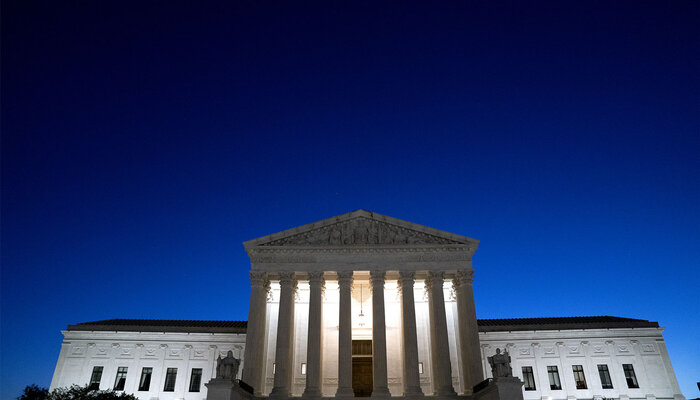Term Limits and a Binding Ethics Code Can Save the Supreme Court from Itself
President Biden’s proposal reflects broad, bipartisan support for major reform.

You’re reading The Briefing, Michael Waldman’s weekly newsletter. Click here to receive it in your inbox.
Supreme Court reform is an issue whose time has come.
In 2021, President Biden appointed me to serve as a member of the Presidential Commission on the Supreme Court of the United States. We were publicly instructed at the outset not to reach conclusions — and we didn’t! (At last, a government agency that works.)
We heard from dozens of public witnesses — 17 on day one alone. They disagreed about many things. But one after another, conservatives and progressives alike said almost offhandedly that of course they supported term limits. It reflected a nascent national consensus.
Still, our report received little more than a terse White House acknowledgment. That makes Biden’s eloquent embrace of reform all the more striking. In a Washington Post op-ed, he declared, “What is happening now is not normal, and it undermines the public’s confidence in the court’s decisions, including those impacting personal freedoms. We now stand in a breach.”
What changed? The Supreme Court has vast power and minimal accountability. Public trust has plunged to the lowest level ever recorded. The Court is mired in corruption controversies. And the Trump v. United States ruling giving presidents broad immunity will sanction executive lawbreaking on an unprecedented scale.
Biden backed 18-year term limits for justices, with a regular appointment every two years. He called for binding ethics rules for justices to replace the toothless ethics code the Court hastily posted online last year. And he supported a constitutional amendment to undo the appalling immunity decision.
In many ways, these are conservative ideas. Term limits rest on a foundational premise of accountability: nobody should hold too much public power for too long. George Washington taught us that when he stepped down after two terms. A binding ethics code confirms that nobody is so wise that they can be the judge in their own case. And the constitutional amendment would restore the understanding that held for two centuries: presidents are not kings, and nobody is above the law. This compelling package would save the Court from itself.
Reform will now be a central public issue going forward. Vice President Harris, running to succeed Biden, endorsed the push. Nobody pretends the changes will happen this year. But if the political stars align after the November election, as Politico reports, things could change fast.
Not surprisingly, the new call for reform has drawn fire. Yesterday the Wall Street Journal called it “political.” Today they called it “radical.” Who knows what they will call it tomorrow?
In fact, a broad and growing public consensus supports term limits. Few policy ideas have such durable bipartisan appeal. According to a recent poll by Fox News, 78 percent of Americans support the idea, up from 66 percent in 2022. A few years ago, the National Constitution Center convened progressive and conservative scholars to put forward dueling ideas for Court reform. Both groups embraced term limits.
So did John Roberts. While working as a White House attorney, he wrote that term limits “would ensure that federal judges would not lose all touch with reality through decades of ivory tower existence” and “would also provide a more regular and greater degree of turnover among the judges. Both developments would, in my view, be healthy ones.” Indeed, the idea was first pushed in 2002 by Federalist Society cofounder Steven Calabresi in an article with liberal constitutional law scholar Akhil Reed Amar.
Now, nobody is under any illusion that bipartisan public support will cause partisan division to melt away in Congress. But if the public’s support is strong enough, the political system can be prodded to respond.
One critic, a fellow commission member, warns this is merely a repackaging of dreaded “court packing.” The Journal editorialists call it “court smacking.” But that dad joke inadvertently reveals the truth. This idea is not a retaliatory expansion of the Court designed simply to outvote conservatives, which might in turn be followed by a further expansion to overwhelm the liberals and so on. It is a principled way to bring the Court into line with a changing country. It would also align the Court with the practice of supreme courts in all but one state, for example.
Term limits can be enacted by constitutional amendment, to be sure, and they also can be enacted by statute. As another fellow commission member, constitutional law scholar Kermit Roosevelt III, explains in Time, Congress has the power to create senior judgeships with different and limited responsibilities, and courts, including the Supreme Court, have upheld that. One version of the proposal would apply the idea to sitting justices. As Roosevelt writes, “David Souter, Anthony Kennedy, and Stephen Breyer are all still Supreme Court Justices, even though they are retired. None of them has left their office.” Another would apply only to new justices while giving the president the power to make an appointment every two years. Details remain to be worked out (including whether current or only future justices would be covered).
Some say all this will politicize the Court. Consider me shocked, shocked that there is politics around Supreme Court nominations. We all know how intense, poisonous, and partisan nomination battles have become. Justices now routinely squeak by on a party-line vote. The legendary New York Times reporter Linda Greenhouse put it well: “With the accuracy of a drone strike, the three justices appointed by President Donald Trump and strong-armed through to confirmation by Mitch McConnell, then the majority leader, are doing exactly what they were sent to the court to do.”
Term limits and regular appointments would help drain the toxicity of the confirmation process. Each nomination would matter less. If candidates felt it necessary to hint at whom they would appoint in advance, so what? Trump announced that he would only appoint justices from a list given to him by the Federalist Society and the Heritage Foundation. (Yes, the same Heritage Foundation, publisher of the notorious Project 2025, that Trump now claims never to have heard of.)
Above all, this makes the issue of Supreme Court reform a central topic going forward. The Brennan Center’s newly launched Kohlberg Center on the U.S. Supreme Court will do its part to bring substantive depth to discussions of a subject that is far from new. The Court and its role have been central political topics many times. Outrage at Dred Scott lifted Abraham Lincoln and the new Republican Party into the White House. Theodore Roosevelt campaigned against reactionary rulings and urged reform in his 1912 run. Conservatives from Richard Nixon to Ronald Reagan to Donald Trump vowed to change the Court.
In short, this is not a distraction from urgent political debates, as some argue. Voters will cast ballots this year in large measure driven by their views of rulings such as Dobbs, which reversed the Constitution’s guarantee of reproductive freedom. Candidates will make pledges about what kind of justice they would appoint, as they should. But reform of a corrupted and unaccountable public institution should be part of the debate as well. As it has been at every moment of peril and progress for American democracy, in 2024 the Supreme Court will be on the ballot.





